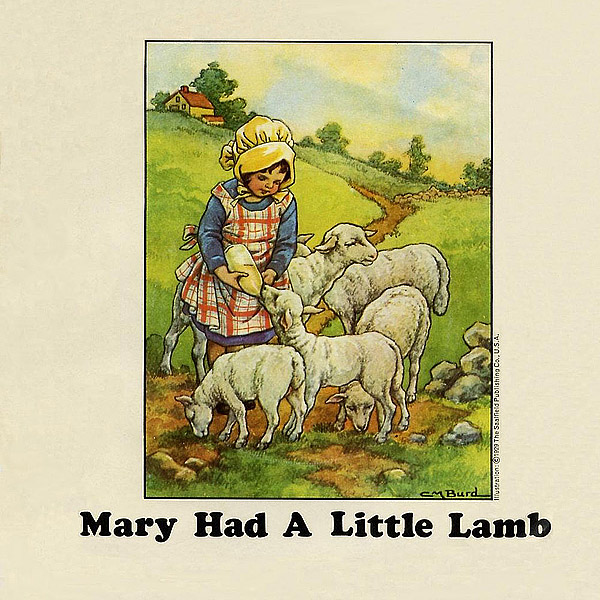
Thursday, October 12, 1972
“Mary Had A Little Lamb” (Psychedelic version) broadcast on US TV
Last updated on April 30, 2022

Thursday, October 12, 1972
Last updated on April 30, 2022
Article Oct 10, 1972 • Paul McCartney's 1961 Höfner 500/1 bass is stolen
Article Oct 11, 1972 • Paul McCartney appeals for the return of a stolen guitar
Article Oct 12, 1972 • "Mary Had A Little Lamb" (Psychedelic version) broadcast on US TV
Session Oct 18, 1972 • Overdubs for "Night Owl"
Session Oct 19, 1972 • Recording "Live And Let Die" #1
Next article Nov 14, 1972 • Photo shoot with Robert Ellis
Mary Had A Little Lamb / Little Woman Love (UK)
By Wings • 7" Single
Officially appears on Mary Had A Little Lamb / Little Woman Love (UK)
Mary Had A Little Lamb (Psychedelic version)
1972 • For Wings • Directed by Nicholas Ferguson
“Mary Had a Little Lamb” was released in March 1972 as Wings’ second non-album single. Four promotional videos were made to support the release.
On this day, the “Psychedelic” promotional video was broadcast for the first and last time on the “Flip Wilson Show” on US TV, on the NBC channel.
From Wikipedia:
The Flip Wilson Show is an hour-long variety show that originally aired in the US on NBC from September 17, 1970, to June 27, 1974. The show starred American comedian Flip Wilson; the program was one of the first American television programs starring a black person in the title role to become highly successful with a white audience. Specifically, it was the first successful network variety series starring an African American. During its first two seasons, its Nielsen ratings made it the nation’s second most watched show.
Overview
The show consisted of many skits in a 60-minute variety format. It also broke new ground in American television by using a “theatre-in-the-round” stage format, with the audience seated on all sides of a circular performance area (with some seats located behind the sketch sets on occasion).
Wilson was most famous for creating the role of Geraldine Jones, a sassy, modern woman who had a boyfriend named Killer (who, when not in prison, was at the pool hall). Flip also created the role of Reverend Leroy, who was the minister of the Church of What’s Happening Now! New parishioners were wary of coming to the church as it was hinted that Reverend Leroy was a con artist. Wilson popularized the catchphrase “The Devil made me do it!”.
Geraldine Jones was a huge part of The Flip Wilson Show and was played by Wilson wearing women’s clothing. Some of “Geraldine’s” most famous quotes are, “The Devil made me buy this dress!”, “Don’t you touch me, honey, you don’t know me that well! You devil, you!” and “What you see is what you get!”
In addition to the skits, Wilson also signed many popular singers to provide entertainment. African-American singers such as Ella Fitzgerald, James Brown, Louis Armstrong, Lena Horne, Stevie Wonder, The Jackson 5, The Chi-Lites, Ray Charles, Aretha Franklin, Gladys Knight & the Pips, The Pointer Sisters, Charley Pride, Johnny Mathis, The Temptations, and The Supremes appeared on the program, as well as many contemporary white entertainers like Bobby Darin (a frequent guest on his show), Bing Crosby (two appearances), Roy Clark, Joan Rivers, The Osmonds, Johnny Cash, Roger Miller, and Pat Boone. Usually, the singers also chose to partake in skits with Wilson.
Wilson’s clout allowed him to get both the new breakout performers (such as The Jackson 5, Roberta Flack, Sandy Duncan, Lily Tomlin, George Carlin, Bill Cosby, Richard Pryor, Albert Brooks, Lola Falana, and Melba Moore, all of whom became very popular during this period) as well as established singers. In late 1971, gospel legend Mahalia Jackson made one of her last public performances on The Flip Wilson Show.
While The Flip Wilson Show first shared a studio with other television series, Wilson’s massive popularity allowed for him to get his own set of soundstages, starting in the fall 1972 season. As the seasons went on, however, the show’s ratings slipped; ratings across the variety show genre began a terminal decline in the mid-1970s. This, coupled with Wilson’s repeated demands for higher raises in his salary, caused the series to go over its budget and led to its cancellation. […]









The Beatles Diary Volume 2: After The Break-Up 1970-2001
"An updated edition of the best-seller. The story of what happened to the band members, their families and friends after the 1970 break-up is brought right up to date. A fascinating and meticulous piece of Beatles scholarship."
We owe a lot to Keith Badman for the creation of those pages, but you really have to buy this book to get all the details - a day to day chronology of what happened to the four Beatles after the break-up and how their stories intertwined together!
The Beatles - The Dream is Over: Off The Record 2
This edition of the book compiles more outrageous opinions and unrehearsed interviews from the former Beatles and the people who surrounded them. Keith Badman unearths a treasury of Beatles sound bites and points-of-view, taken from the post break up years. Includes insights from Yoko Ono, Linda McCartney, Barbara Bach and many more.

Notice any inaccuracies on this page? Have additional insights or ideas for new content? Or just want to share your thoughts? We value your feedback! Please use the form below to get in touch with us.